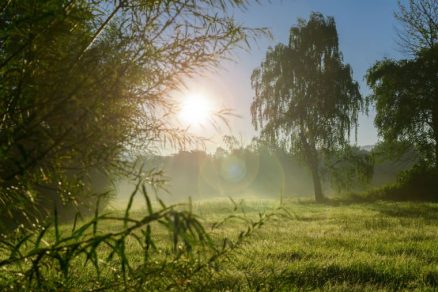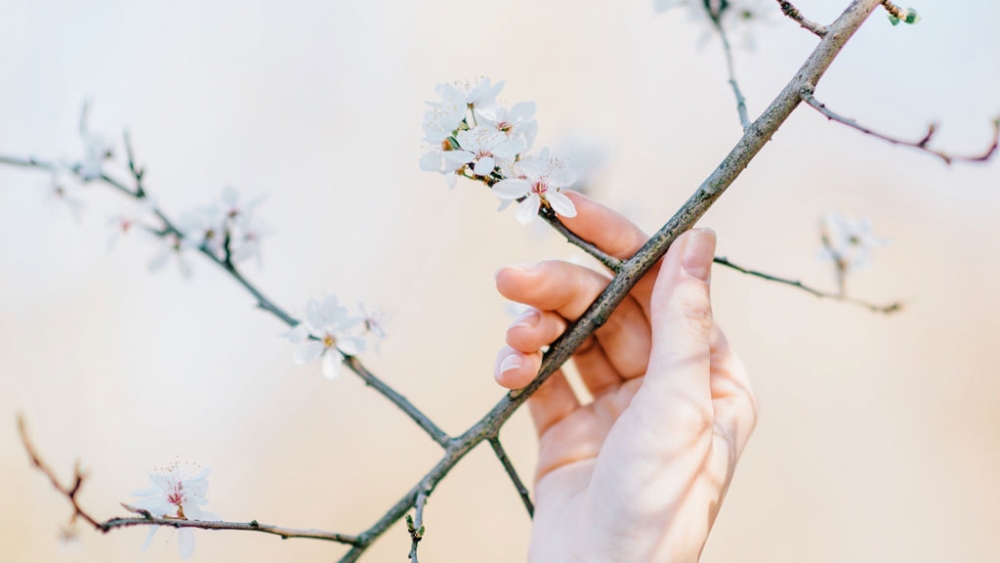Ayurveda, or ‘life knowledge’ is all about finding balance, and enabling each person’s internal environment (the body and mind) to work harmoniously with their external environment (the outside world).
Living in alignment with the seasons is one of the best ways to help support health and wellbeing, helping to balance the immune system, digestive pathways, and each person’s dosha. There are three doshas: Vata, Pitta, and Kapha. To learn more about them and discover your own, take this dosha quiz.
Just as each person has a predominant dosha, each time of day and each season is also governed by a particular dosha. Spring is closely linked to Kapha, with the qualities of moistness, heaviness, abundance, but also lethargy – and related to the elements of earth and water. Allergies can become apparent at this time of year, and it’s easy to become more susceptible to mucus forming in the respiratory tract.
Ayurvedic expert Vasant Lad refers to Spring as the ‘King of the seasons’, and in the Yogic text the Bhagavad Gita, Krishna reveals himself with various attributes:
“I am the Soul in the body, the Mind in the senses, the Eagle among birds, the Lion among animals. Among all the trees I am the sacred Bodhi tree, and of the seasons, I am Spring”.
Whilst Winter may be all about getting cosy and filling up on comfort foods, we may enter into Spring feeling heavy and sluggish. So it’s time to lighten things up, and shed the many aspects of our ‘Winter coat’, to allow new growth and abundance during the coming months.
It’s time to lighten things up and shed the many aspects of our ‘Winter coat’, to allow new growth and abundance.
Potential signs of ‘imbalance’ include congestion, a loss of appetite, allergies, or lethargy, so if you’re experiencing any of these, an Ayurvedic Springtime routine may be able to help!
Daily Springtime routines
1. Rise with the sun

As new life blooms all around us, this is a great time to get outside and enjoy nature as it flourishes. Aim to wake with the sunrise and spend a portion of the morning (even if it’s just ten minutes) walking outside, breathing in the fresh air and exposing your eyes to the beneficial morning light.
This is a great way to relieve feelings of sluggishness, to boost energy levels and reset the body clock, as the amount of daylight increases for those of us in the UK and Europe. Napping during the daytime is not recommended during Kapha season, as this can increase sluggishness and prevent a good night’s sleep.
2. Body brushing
The practice of body brushing is intended to remove dead skin cells and increase circulation. Ayurvedic traditions often include various daily cleansing practices like this as part of a Dinacharya or morning routine. This can be a great way to enhance your energy and blood flow in the morning.
3. Abhyanga massage
Self-massage and the use of oils are another important aspect of Ayurveda, but with this time of year already leaning towards oiliness and moistness, it’s important to choose your oils wisely. Light oils like almond or grapeseed, and essential oils such as ginger, black pepper, lemon, bergamot, grapefruit or clove can all help boost circulation and mood levels during Spring, especially for those of a Kapha dosha.
4. Herbal help
Adding various herbs to meals can be a wonderful and effective way to balance the body. Herbs such as ginger, pippali, cumin, coriander, and fennel are useful, and can also be made into a tea. A particularly effective tea for relieving heaviness and bloating after meal times consists of cinnamon, black pepper, and ginger. Read more in Ayurvedic herbal teas for Spring.
5. Foods and tastes
Heavy, oily food is best avoided at this time of year. Vasant Lad advises against eating sour, sweet and overly salty foods, as they ‘provoke Kapha’. Cold drinks and dairy products are also best avoided. Foods to favour include bitter, pungent and astringent tastes, like lemon, dark leafy greens, chilli, garlic, legumes, radishes, and berries. (You may notice that many of these foods are also beginning to come into season!) These are all said to help detoxify the body, stimulate digestion and metabolism, and ‘dry up’ excess fats. Honey can provide a ‘heating’ action in the body, and is useful to consume at this time of year in order to increase Agni, or ‘digestive fire’. A cup of warm water with a teaspoon of honey may prove useful in balancing Kapha energies at this time of year.
6. Kapha balancing yoga postures

Heating, energy-enhancing postures like Navasana, twists, backbends, and Sun Salutations can help relieve feelings of sluggishness. Pranayama techniques like Surya Bhedana (right nostril breathing) are also warming and stimulating.
7. Cleansing, fasting & Panchakarma
Spring is generally thought of as the ideal time to cleanse, according to Ayurveda. Whilst many of us may have attempted a new year ‘detox’, it’s easy to see how difficult and possibly unnecessary detoxing in the Winter really is. The body needs nourishment and internalisation during Winter’s Vata time, but as we enter into the Kapha season, this is truly the ideal time to observe these detoxifying practices.
Panchakarma means ‘five actions’, and is the (rather vigorous) Ayurvedic cleansing and purifying program traditionally undertaken in order to detox and rejuvenate the body. The five actions consist of Vamana, Virechana, Nasya, Basti, and Raktamoskshana. These techniques are not commonly practised in the West, and in order to make the process more accessible, realistic and enjoyable, a Spring cleanse can consist of a mono diet of Kitchari, a three-day juicing cleanse, intermittent fasting, cutting out sugars and processed foods, refraining from snacking between meals, or simply reducing caffeine in order to allow the body to rid itself of unnecessary toxins. It’s advisable to seek advice from a qualified doctor or therapist if you are considering taking part in a fast or cleanse.
As we move from the darkness of Winter into the light of Spring, honour your body and mind by feeding it well, breathing fully, and moving in a way that feels good to you. Enjoy the new colours and sense of new beginnings, and as always – listen to your body, it’s your best teacher!

